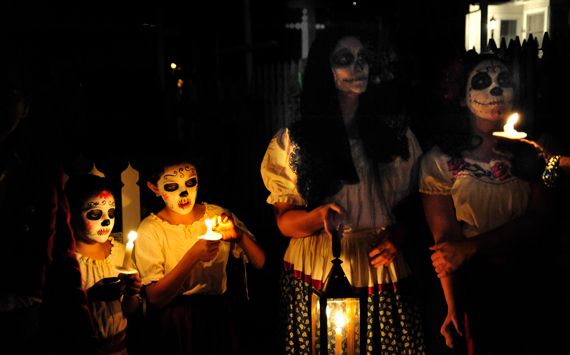|

Modern Observances
"In Mexico, the festival of Día de los Muertos embodies the greatest expression of both popular Catholicism and national cuisine. People construct alters in homes and graveyards throughout the country in order to feed the souls of the dead.
Church officials recognize two holy days, November 1 (All Saints Day)...and November 2 (All Souls Day), in memory of the faithful departed. According to popular belief, the angelitos (deceased children) return on the evening of October 31 and the adults on the following night, although the dates in local celebrations vary all the way from October 28 to November 4.
The feast for the dead originated as a form of ancestor worship, and the clergy were long reluctant to incorporate such pagan practices into the liturgical calendar. The festival held particularly strong associations with pre-Hispanic agrarian cults because it coincided with the maize harvest.
Celebrations begin with the cleaning of the graves and the construction of the altar. At home this consists of a table or platform hung from the ceiling, covered with a white cloth and supporting an arch of palm fronds. The ofrenda are decorated with flowers, particularly the cempasuhil (marigold), the 'flower of the dead.'
The foods offered to the dead vary according to age and taste, but bread, water, and salt are always included. The bread is made from a special egg dough forming bones, and a skull in the center. Sugar candies with similar skull and calavera (skeleton) designs are also popular. In some areas of Oaxa and Michoacan, bakers shape the bread to resemble humans or animals. Offerings for children are miniature in size and relatively simple: breads, candies, fruits, and milk or soft drinks. The adult dead receive the finest foods, grown-up breads and sugar figures, as well as candied pumpkin and other sweets. More elaborate preparations include mole (turkey in a rich chili sauce) and tamales (corn dumplings stuffed with meat and chili and steamed in husks or banana leaves).
The spirits also drink their favorite beverages, whether soft drinks, coffee, chocolate, beer or tequila. The Day of the Dead has recently become an important tourist attraction for the towns such as Mixquic, near Mexico City, and in the state of Oacaca." - Day of the Dead, Encyclopedia of Food and Culture, Solomon H. Katz, editor in chief [Charles Scribner:New York] 2003, Volume 1 (p. 505-506)
|
HISTORY & CULTURE
|

